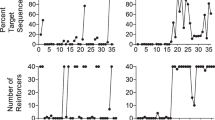Abstract
To examine schedule control over following instructions comprised of novel combinations of verbal stimuli, three children, from 8 to 10 years old, received either continuous or intermittent reinforcement for a chain of buying and then following such instructions. Later, a series of training-extinction tests was conducted. During the training trials, the chain produced either continuous or intermittent reinforcement. During the extinction trials, buying produced instructions but following instructions never produced reinforcement. For one subject, a partial reinforcement extinction effect was detected for the chain. For two subjects, a stimulus correlated with extinction onset enhanced schedule control. Overall, the frequency of the chain covaried with the probability of reinforcement. The schedule effects detected and the methodology used extend the generality of an operant interpretation of instruction following to instructions comprised of novel combinations of verbal stimuli.
Similar content being viewed by others
References
ANGER, D., & ANGER, K. (1976). Behavior changes during repeated eight-day extinctions. Journal of the Experimental Analysis of Behavior, 26, 181–190.
BAER, D. M., PETERSON, R. F., & SHERMAN, J. A. (1967). The development of imitation by reinforcing behavioral similarity to a model. Journal of the Experimental Analysis of Behavior, 10, 405–416.
BARON, A., & GALIZIO, M. (1983). Instructional control of human operant behavior. The Psychological Record, 33, 495–520.
BARON, A., PERONE, M., & GALIZIO, M. (1991). The experimental analysis of human behavior: Indispensable, ancillary, or irrelevant? The Behavior Analyst, 14, 145–155.
CATANIA, A. C. (1992). Learning (3rd ed.). Englewood Cliffs, NJ: Prentice Hall.
CERUTTI, D. T. (1989). Discrimination theory of rule-governed behavior. Journal of the Experimental Analysis of Behavior, 51, 259–276.
DEGRANDPRE, R. J., & BUSKIST, W. F. (1991). Effects of accuracy of instructions on human behavior: Correspondence with reinforcement contingencies matters. The Psychological Record, 41, 371–384.
FREEMAN, T. J., & LATTAL, K. A. (1992). Stimulus control of behavioral history. Journal of the Experimental Analysis of Behavior, 57, 5–15.
GALIZIO, M. (1979). Contingency-shaped and rule-governed behavior: Instructional control of human loss avoidance. Journal of the Experimental Analysis of Behavior, 31, 53–70.
GONZALEZ, R. C., HOLMES, N. K., & BITTERMAN, M. E. (1967). Asymptotic resistance to extinction in fish and rat as a function of interpolated retraining. Journal of Comparative and Physiological Psychology, 63, 342–344.
HACKENBERG, T. D., & JOKER, V. R. (1994). Instructional versus schedule control of humans’ choices in situations of diminishing returns. Journal of the Experimental Analysis of Behavior, 62, 367–383.
HAYES, L. J., THOMPSON, S., & HAYES, S. C. (1989). Stimulus equivalence and rule following. Journal of the Experimental Analysis of Behavior, 52, 275–291.
HAYES, S. C., & HAYES, L. J. (1989). The verbal action of the listener as a basis for rule-governance. In S. C. Hayes (Ed.), Rule-governed behavior: Cognition, contingencies, and instructional control (pp. 153–190). New York: Plenum.
HYTEN, C. H., MADDEN, G. J., & FIELD, D. P. (1994). Exchange delays and impulsive choice in humans. Journal of the Experimental Analysis of Behavior, 62, 225–233.
LEFRANCOIS, J. R., CHASE, P. N., & JOYCE, J. H. (1988). The effects of a variety of instructions on human fixed-interval performance. Journal of the Experimental Analysis of Behavior, 49, 383–393.
MATTHEWS, B. A., SHIMOFF, E., CATANIA, A. C., & SAGVOLDEN, T. (1977). Uninstructed human responding: Sensitivity to ratio and interval contingencies. Journal of the Experimental Analysis of Behavior, 27, 453–467.
NEVIN, J. A. (1985, May). Reinforcement, extinction, and behavioral momentum. Invited address at the meetings of the Association for Behavior Analysis, Columbus, OH.
NEVIN, J. A. (1988). Behavioral momentum and the partial reinforcement effect. Psychological Bulletin, 103, 44–56.
NEWMAN, B., BUFFINGTON, D. M., & HEMMES, N. S. (1995). The effects of schedules of reinforcement on instruction following. The Psychological Record, 45, 463–476.
NEWMAN, B., HEMMES, N. S., BUFFINGTON, D. M., & ANDREOPOULOS, S. (1994). The effects of schedules of reinforcement on instruction-following in human subjects with verbal and nonverbal stimuli. The Analysis of Verbal Behavior, 12, 31–41.
REESE, H. W. (1989). Rules and rule-governance: Cognitive and behavioristic views. In S. C. Hayes(Ed.), Rule-governed behavior: Cognition, contingencies, and instructional control (pp. 3–84). New York: Plenum.
SCHOENFELD, W. N., & CUMMING, W. W. (1963). Behavior and perception. In S. Koch (Ed.), Psychology: A study of a science (pp. 213–252). New York: McGraw-Hill.
SKINNER, B. F. (1957). Verbal behavior. New York: Appleton-Century-Crofts.
Author information
Authors and Affiliations
Corresponding author
Additional information
This manuscript is based on Rodger’s master’s thesis. Special thanks are due: Alan Baron and Jay Moore for their conceptual contributions; Ivonne Del Moral, Michael Schlund, Tracy Turner, and Fred Wiltzius for data collection and analysis; and Thomas Edgar for editorial suggestions.
Rights and permissions
About this article
Cite this article
Dermer, M.L., Rodgers, J.G. Schedule control over following instructions comprised of novel combinations of verbal stimuli. Psychol Rec 47, 243–260 (1997). https://doi.org/10.1007/BF03395223
Published:
Issue Date:
DOI: https://doi.org/10.1007/BF03395223




